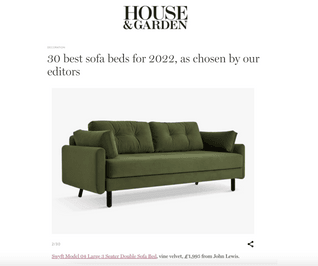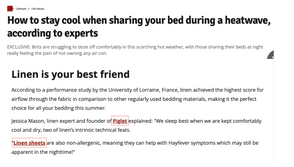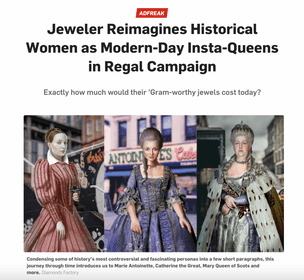Digital PR and eCommerce go hand in hand. If your store sits on the web, it makes sense that most of your PR activity is primarily online too.
Why is that?
Well, if your PR activity is online it helps to drive consumers directly back to your website, where they can purchase your goods!
As well as helping to improve your site’s SEO ranking in the long run, digital PR is great for building brand awareness, boosting sales and giving you insights into who your customers are and how they shop online.
Digital PR refers to the PR tactics used to earn backlinks to your site. These backlinks in turn support your SEO strategy.
5 reasons digital PR is the perfect fit for eCommerce brands
1. It exposes your brand to new audiences
Traditional forms of PR tend to focus on building brand awareness and can be tricky to measure. Digital PR focuses on boosting the authority of your site through building links on lots of different relevant websites, building brand awareness in the process..
Digital PR uses lots of different tactics and types of content to target a broad variety of websites, helping to expose your brand to new audiences
Due to the versatile nature of digital PR campaigns – many include unveiling new research with multiple hooks that relate to a larger audience – you’re able to feature in a wider array of websites. Gaining coverage for new product launches can also be faster than with traditional PR, due to the reduced lead time online compared to print.
2. Links that aren’t sponsored are trusted by Google as votes of confidence in your site
Over the years, Google has evolved to recognise genuine links back to your site. Sponsored and paid-for links are easy to get, but won’t benefit SEO strategy much long-term. Unlike paid and affiliate links, digital PR links are recognised as a good indicator of your site’s trustworthiness and actually help more people to get eyes on your brand in the long run by improving your ranking on Google results pages.
In saying this, having a varied backlink profile is important and having some sponsored backlinks is a good thing. Sponsored links tell Google that your site is a business and still drive traffic to your site.
3. You can target specific category and product pages
Digital PR is not just for building links to your homepage. A targeted digital PR strategy will help you to build deep links which point to your product and category pages, helping you rank for products and relevant keywords on search engine results pages (SERPs). In turn, more consumers will be able to find your products, without having any prior knowledge of your brand or the fact you sell the products they are searching for.
4. It allows you to be fast and reactive
Digital PR is flexible and can be faster than traditional PR, which is why it’s especially great for e-Commerce brands. It enables you to share sales and offers even if they’re last-minute, push products that are suddenly trending on TikTok and give your brand an active voice, commenting on wider industry trends as soon as they crop up.
5. It helps consumers to trust your brand
Digital PR helps to build brand awareness by placing your brand’s content and products on relevant sites next to your direct and aspirational competitors. Appearing on the websites your audience’s trust helps to build faith in your brand, and you may even begin to generate revenue through referral traffic. Consumers will turn to the online publications they trust most for advice in the early stages of the buying journey.
How to know if your brand is ready for digital PR
Digital PR involves a lot more than writing about your products or brand in a sales pitch and reaching out to generic email addresses. Your digital PR strategy will require some significant planning to ensure you are targeting the right publications for your audience with the right content for those publications.
Here’s a 3-point checklist of things you need to consider before jumping into a digital PR strategy:
1. What are your target publications?
Deciding on a list of target publications might seem like an easy task for some brands. Of course, you want to be featured on the biggest titles and the sites with the highest domain ratings. However, sometimes niche blogs and alternative publications can be more relevant to your site and just as beneficial to your SEO efforts. The Google algorithm considers the relevancy of pages that link back to your site, so make sure you’re targeting both your dream publications and smaller, highly relevant websites.
It’s also a good idea to do a link intersect before you create your target media list. Use Ahrefs or Moz to scout out the titles where your competitors are being featured and your brand isn’t. This will help to boost the number of domains referring to your site which is beneficial to SEO. Plus, your competitors that sell similar products being featured on a site already is a great indication the publication’s audience would have an interest in your brand.
Creating a target media list goes beyond pulling generic email addresses from the sites you want to be featured on. For a real chance at getting coverage, you need to create targeted media lists for each of your pitches. This will involve sifting through previous articles to find out which journalists have previously covered the type of content you want to share, and contacting them directly.
2. Which pages on your site do you want to target?
Think about the pages you want to focus on pushing first. If you’re starting out on your digital PR journey, it might be most beneficial to push your products to be featured on shopping guides as you will gain deep links pointing toward your product description pages. Linking to these types of pages is great for generating referral traffic and sales.
Linking to your category pages is also great for user experience, allowing them to click and browse a certain collection easily. This is also of great SEO benefit as these links will help your category pages to appear higher up on the Google search results page and consumers search more general terms (such as ‘bedding’, ‘summer dresses’ or ‘sparkling wine’) can then browse the various options your site has to offer, rather than just being directed to one product. Additionally, if your products frequently sell out or are only available on-site for a certain amount of time, targeting your category pages is the most sustainable method of link-building.
If your product range isn’t suitable for product listicles, isn’t gaining traction or if you are looking to get featured on new domains which are less product-focused, directing links to your blog pages can be a good way to boost the authority of your site and spread brand awareness.
3. What kind of content will you need?
The type of content you need for your digital PR outreach will depend heavily on the pages you want to target on your site and your target publications. We break down our pitches into three main categories:
- Product-led pitches: these types of pitches are outreached exclusively to shopping editors and focus on sharing detailed product information and imagery. These pitches will mainly drive links to your product description and landing pages.
Example of product-led pitching coverage, featuring Swyft sofas in House & Garden
- Reactive campaigns: these are short-form pieces of content sharing tips, hacks or reactive commentary on wider industry trends. These pitches can drive links to a variety of pages, including blogs, product category and description pages depending on where you link to in the pitch and if your products are relevant to the story you are telling.
Example of reactive campaign coverage, featuring Piglet in Bed in OK!
- Campaigns: these are larger content pieces that often share new data or unique, creative assets. Read more about how to source data for your digital PR campaigns here. These pitches should drive links to your campaign landing page (which will be usually be uploaded on your site’s blog.
Example of creative campaign coverage, featuring Diamonds Factory in Adweek



